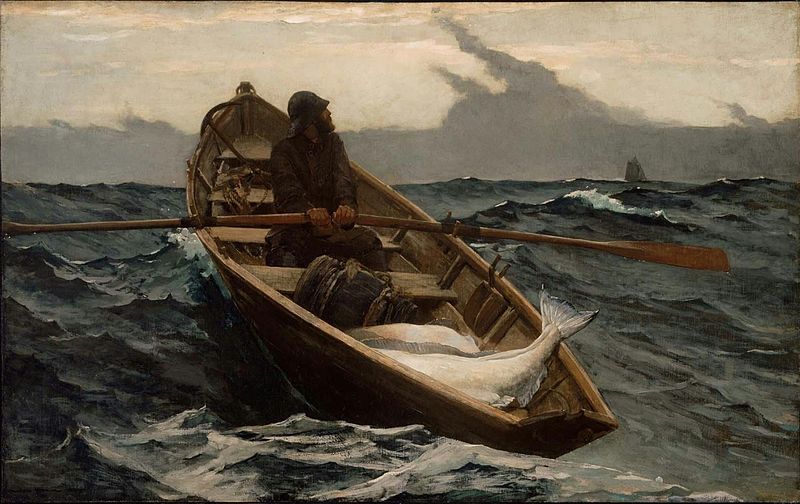Yesterday I reported on my faculty book group’s discussion of analytic philosopher Adrienne Martin’s How We Hope: A Moral Psychology. Members of the English Department brought in two poems to supplement the discussion, and in my post I looked at Emily Dickinson’s “Hope is that thing with feathers.” Today I turn to the other poem, Elizabeth Bishop’s “The Fish.”
First, however, I share some clarity I got from talking about a subject both philosophically and literarily. Philosophy, at least as Adrienne Martin practices it, is better at analyzing hope that conveying what it feels like to hope. Analytical knowledge offers up one kind of knowledge—a precise and scientific knowing—but it doesn’t appear to provide the intuitive understanding that comes with inhabiting a literary work. Dickinson does far better than Martin at conveying how remarkable a “thing” hope is.
This is not a criticism of philosophy. Each discipline has its own strengths and limitations, and a liberally educated person will look at the world through multiple lenses. In some ways literary scholars, with their systematic interpretations, are more akin to philosophers than they are to creative writers and can use philosophic tools to sort out literary vision. On the other hand, by making literature their subject, they may be more apt than philosophers to appreciate the special kind of knowing that artists provide.
Turning now to literary authors, they themselves benefit from knowing philosophy. I believe it was Italian social philosopher Antonio Gramsci who argued that writers should be conversant with the most recent advances in philosophy as they attempt to make sense of the world. There is a rational as well as an intuitive dimension to art, and writers have a special facility for synthesizing sense and verbal sound.
I should note that Plato doesn’t agree. In The Ion, Socrates interviews an artist–a rhapsode who gives dramatic readings–and concludes (or gets Ion to conclude) that artistic power is not science (artifice) but divine madness (inspiration). Is this an instance of a philosopher disrespecting the arts as some artists disrespect philosophy? I myself would argue for “both/and” rather than “either/or.”
So what insights does Bishop’s “The Fish” give us about hope? Here’s the poem:
The Fish
By Elizabeth Bishop
I caught a tremendous fish
and held him beside the boat
half out of water, with my hook
fast in a corner of his mouth.
He didn’t fight.
He hadn’t fought at all.
He hung a grunting weight,
battered and venerable
and homely. Here and there
his brown skin hung in strips
like ancient wallpaper,
and its pattern of darker brown
was like wallpaper:
shapes like full-blown roses
stained and lost through age.
He was speckled with barnacles,
fine rosettes of lime,
and infested
with tiny white sea-lice,
and underneath two or three
rags of green weed hung down.
While his gills were breathing in
the terrible oxygen
–the frightening gills,
fresh and crisp with blood,
that can cut so badly–
I thought of the coarse white flesh
packed in like feathers,
the big bones and the little bones,
the dramatic reds and blacks
of his shiny entrails,
and the pink swim-bladder
like a big peony.
I looked into his eyes
which were far larger than mine
but shallower, and yellowed,
the irises backed and packed
with tarnished tinfoil
seen through the lenses
of old scratched isinglass.
They shifted a little, but not
to return my stare.
–It was more like the tipping
of an object toward the light.
I admired his sullen face,
the mechanism of his jaw,
and then I saw
that from his lower lip
–if you could call it a lip
grim, wet, and weaponlike,
hung five old pieces of fish-line,
or four and a wire leader
with the swivel still attached,
with all their five big hooks
grown firmly in his mouth.
A green line, frayed at the end
where he broke it, two heavier lines,
and a fine black thread
still crimped from the strain and snap
when it broke and he got away.
Like medals with their ribbons
frayed and wavering,
a five-haired beard of wisdom
trailing from his aching jaw.
I stared and stared
and victory filled up
the little rented boat,
from the pool of bilge
where oil had spread a rainbow
around the rusted engine
to the bailer rusted orange,
the sun-cracked thwarts,
the oarlocks on their strings,
the gunnels-until everything
was rainbow, rainbow, rainbow!
And I let the fish go.
As the poem begins, it appears that the fish is more resigned than hopeful: it doesn’t fight at all. The poem is not about the fish, however, but the meaning the poet gets from what she sees. As she examines the animal closely, she recognizes that it has escaped death time and again. At least five times it has been caught by people and escaped.
The more she looks, the more she sees–the poem moves beyond its short, matter-of-fact sentences–and the reader shares her growing awe and excitement. The dangling threads appear as military ribbons, which the fish coming to resemble an old combat veteran, and the speaker feels herself in the presence of ancient wisdom, begotten from brushes with death and the experience of suffering. Suddenly everything in her small and somewhat commonplace life is transformed. The rented boat with its rusty engine, its oily puddle of bilge water, sun-cracked thwarts, is filled with rainbow, rainbow, rainbow.
The fish escapes certain death to swim once again. It is not fruitless to hope against hope.
